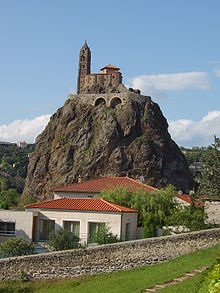Chimney (geology)


As vent (also vent passage , volcanic vent , punch tube , Blasts Judge , diatreme , Neck or eruption vent ) is known in geology more or less vertical rise channel of volcanic products from the earth's interior to a eruption center at the earth's surface or on the seabed.
shape
Depending on the shape and location, the chimneys are called volcanic craters , eruption fissures or volcanic domes . Well-known examples are the tuff chimneys of the Swabian Alb and the necks in Scotland , including Bass Rock .
Emergence
Chimneys are usually formed by explosive eruptions of very gas-rich magmas or by pure gas eruptions from great depths, which are often linked to tectonic weak zones such as faults or fissures , but sometimes also due to evaporating groundwater. Due to the pressure relief when the magma rises rapidly, there is such a sudden degassing and volume increase of carbon dioxide and water vapor that the rock debris can reach supersonic speeds. The process is somewhat similar to opening a warm bottle of sparkling wine that has been vigorously shaken beforehand.
Chimney filling
The rocks that solidify or sediment in the chimney (mostly only a little lava , mostly volcanic breccias ) form the chimney filling, also known as the chimney plug. As a result of the explosive eruption process, numerous fragments of adjacent rock are often carried away by the chimney walls ( xenolites ). These can sometimes make up a significant proportion of the chimney filling.
The deposits of diamond-bearing pipes made of kimberlite and Lamproit in South Africa are of economic interest . They are at least three times as deep as most of the other known chimneys and reach into the deep crust of the earth or even into the upper mantle, where the diamonds come from. Their root zones usually consist of solidified magma. The proportion of breccias increases towards the top.
Because of their broken, loose filling, volcanic chimneys can also easily serve as routes for ascent and deposition sites for mineralizing solutions ( fluids ) from the depths. Many known deposits of copper and other metals are bound to such structures.
In the broadest sense, however, any cone-shaped body made of rock debris can also be called a chimney, regardless of whether it is of volcanic origin or not. In speleology , vertical stretches of a cave are sometimes referred to as a vent. In contrast to the shaft, the chimneys developed from the bottom up.
See also
literature
- Hans Murawski, Wilhelm Meyer: Geological dictionary. 10th edition, Enke Verlag, Stuttgart 1998, ISBN 3-432-84100-0

